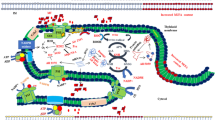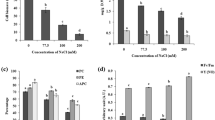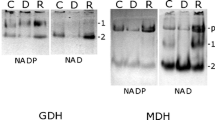Abstract
The current study describes the mechanisms of zinc toxicity in the cyanobacterium Anabaena sphaerica after eight days treatment with 10 mg L−1 ZnCl2. The application of zinc not only showed elevated accumulation of the metal inside the cells but also exhibited devastating impacts on the cell numbers, morphology, and ultrastructure of A. sphaerica. The effects of zinc on the pigments contents, oxygen evolution rate, Fv/Fm, electron transport rate, and carbohydrate content were also evaluated in A. sphaerica. Moreover, zinc adversely affected nutrient uptake and the cellular energy budget in the test cyanobacterium which in turn hampered heterocyst development and nitrogen fixation. Alongside, the cyanobacterium experienced zinc-mediated non-competitive inhibition of glutamine synthetase activity, curtailed synthesis of amino acids and proteins. Furthermore, drastically reduced total lipid and increased unsaturated lipid contents were also the prominent characteristics of zinc stressed A. sphaerica. Most importantly, zinc stress caused severe damages to the protein, lipid, and DNA by triggering hydrogen peroxide generation and accumulation of oxidized glutathione. Therefore, excess zinc is highly toxic to the cyanobacterium A. sphaerica, and the mechanisms of its toxicity followed a cascade of events including oxidative stress mediated geopardisation of growth and ultrastructure, metabolic derangements, and macromolecular damages.
Graphical abstract







Similar content being viewed by others
Data availability
All data generated or analyzed during this study are included in this published article [and its supplementary information files].
References
Ada FB, Ayotunde EO, Offem BO (2012) Surface and ground water concentrations of metal elements in central cross river state, Nigeria, and their suitability for fish culture. Int J Environ Sustain 2:9–20
Anyanwu BO, Ezejiofor AN, Igweze ZN, Orisakwe OE (2018) Heavy metal mixture exposure and effects in developing nations: an update. Toxics 6:65
Baebprasert W, Jantaro S, Khetkorn W, Lindblad P, Incharoensakdi A (2011) Increased H2 production in the cyanobacterium Synechocystis sp. strain PCC 6803 by redirecting the electron supply via genetic engineering of the nitrate assimilation pathway. Metab Eng 13:610–616
Balaji S, Kalaivani T, Rajasekaran C (2014) Biosorption of zinc and nickel and its effect on growth of different Spirulina strains. Clean Soil Air Water 42:507–512
Balakrishnan K, Rajendran C, Kulandaivelu G (2000) Differential responses of iron, magnesium, and zinc deficiency on pigment composition, nutrient content, and photosynthetic activity in tropical fruit crops. Photosynthetica 38(3):477–479
Bazihizina N, Taiti C, Marti L, Rodrigo-Moreno A, Spinelli F, Giordano C, Caparrotta S, Gori M, Azzarello E, Mancuso S (2014) Zn2+-induced changes at the root level account for the increased tolerance of acclimated tobacco plants. J Exp Bot 65:4931–4942
Bbosa NB, Oyoo WS (2013) Seasonal variations of phytoplankton species in lake Victoria and the influence of iron and zinc ions on the dominant species identified during 2006–2007 studies. Lakes Reserv Res Manag 18:259–273
Bernat G, Rögner M (2011) Center of the cyanobacteria electron transport network: the cytochrome b6f complex. In: Peschek GA, Obinger C, Renger G (eds) Bioenergetic processes of cyanobacteria: from evolutionary singularity to ecological diversity. Springer, Dordrecht, pp 573–606
Bickel PJ, Kechris KJ, Spector PC, Wedemayer GJ, Glazer AN (2002) Finding important sites in protein sequences. Proc Natl Acad Sci 99(23):14764–14771
Bradford MM (1976) A rapid and sensitive method for the quantitation of microgram quantities of protein utilizing the principle of protein-dye binding. Anal Biochem 72:248–254
Bradl ADL (2005) Heavy metals in the environment, vol 282. Elsevier, London
Ceribasi IH, Yetis U (2001) Biosorption of Ni (II) and Pb (II) by Phanerochaete chrysosporium from a binary metal system - kinetics. Water SA 27:15–20
Chakraborty S, Mishra A (2020) Mitigation of zinc toxicity through differential strategies in two species of the cyanobacterium Anabaena isolated from zinc polluted paddy field. Environ Pollut 263(Part B):114375
Chakraborty P, Babu PVR, Acharyya T, Bandyopadhyay D (2010) Stress and toxicity of biologically important transition metals (Co, Ni, Cu, and Zn) on phytoplankton in a tropical freshwater system: an investigation with pigment analysis by HPLC. Chemosphere 80:548–553
Chakraborty S, Tiwari B, Singh SS, Srivastava AK, Mishra AK (2017) Differential physiological, oxidative and antioxidative responses of cyanobacterium Anabaena sphaerica to attenuate malathion pesticide toxicity. Biocatal Agric Biotechnol 11:56–63
Chakraborty S, Mishra A, Verma E, Tiwari B, Mishra AK, Singh SS (2019) Physiological mechanisms of aluminum (Al) toxicity tolerance in nitrogen-fixing aquatic macrophyte Azolla microphylla Kaulf: phytoremediation, metabolic rearrangements, and antioxidative enzyme responses. Environ Sci Pollut Res Int 26:9041–9054
Chaloub RM, de Magalhães CCP, Dos Santos CP (2005) Early toxic effects of zinc on PSII of Synechocystisaquatilis f. aquatilis (cyanophyceae). J Phycol 41:1162–1168
Cheng YS, Zheng Y, Vander-Gheynst JS (2011) Rapid quantitative analysis of lipids using a colorimetric method in a microplate format. Lipids 46:95–103
Chibuike GU, Obiora SC (2014) Heavy metal polluted soils: effect on plants and bioremediation methods. Appl. Environ. Soil Sci. 752708.
Choudhary M, Jetley UK, Abash Khan M, Zutshi S, Fatma T (2007) Effect of heavy metal stress on proline, malondialdehyde, and superoxide dismutase activity in the cyanobacterium Spirulina platensis-S5. Ecotoxicol Environ Saf 66:204–209
Cramer WA, Hasan SS, Yamashita E (2011) The Q cycle of cytochrome bc complexes: a structure perspective. Biochim Biophys Acta-Bioenergetics 1807:788–802
Danilov RA, Ekelund NGA (2001) Responses of photosynthetic efficiency, cell shape and motility in Euglena gracilis (Euglenophyceae) to short-term exposure to heavy metals and pentachlorophenol. Water Air Soil Pollut 132:61–73
Davis MS and Cronan JE (2001) Inhibition of Escherichia coli acetyl coenzyme A carboxylase by acyl-acyl carrier protein. J Bacteriol 183:1499–1503
Day JW, Kemp WM, Yáñez-Arancibia A, Crump BC (2012) Estuarine ecology. Wiley, New York City
De Magalhães CCP, Cardoso D, Dos Santos CP, Chaloub RM (2004) Physiological and photosynthetic responses of Synechocystis aquatilisf.aquatilis (Cyanophyceae) to elevated levels of zinc. J Phycol 40:496–504
Dubois M, Gilles RA, Hamilton FK (1956) Calorimetric method for determination of sugar and related substances. Anal Chem 28:350–356
Erbe JL, Adams AC, Taylor KB, Hall LM (1996) Cyanobacteria carrying an smt-lux transcriptional fusion as biosensors for the detection of heavy metal cations. J Ind Microbiol 17:80–83
Fales FW (1971) Evaluation of a spectrophotometric method for determination of total fecal lipid. Clin Chem 17:1103–1108
Gonzalo S, Rodea-Palomares I, Leganés F, García-Calvo E, Rosal R, Fernández-Piñas F (2014) First evidences of PAMAM dendrimer internalization in microorganisms of environmental relevance: a linkage with toxicity and oxidative stress. Nanotoxicology 9:706–718
Heath RL, Packer L (1968) Photoperoxidation in isolated chloroplasts. I. Kinetics and stoichiometry of fatty acid peroxidation. Arch Biochem Biophys 125:189–198
Hider RC, Kong XL (2011) Glutathione: a key component of the cytoplasmic labile iron pool. Biometals 24:1179–1187
Hudek L, Rai LC, Freestone D, Michalczyk A, Gibson M, Song YF, Ackland ML (2009) Bioinformatic and expression analyses of genes mediating zinc homeostasis in Nostoc punctiforme. Appl Environ Microbiol 75:784–791
Ishida A, Yamada Y, Kamidate T (2008) Colorimetric method for enzymatic screening assay of ATP using Fe (III)-xylenol orange complex formation. Anal Bioanal Chem 392:987–994
Kang JX, Wang J (2005) A simplified method for analysis of polyunsaturated fatty acids. BMC Biochem 6:5
Kirilovsky D, Kerfeld CA (2013) The orange carotenoid protein in photoprotection of photosystem II in cyanobacteria. Biochim Biophys Acta Bioenerg 1817:158–166
Kondzior P, Butarewicz A (2018) Effect of heavy metals (Cu and Zn) on the content of photosynthetic pigments in the cells of algae Chlorella vulgaris. Ecol Eng 19:18–28
Latifi A, Ruiz M, Zhang CC (2009) Oxidative stress in cyanobacteria. FEMS Microbiol Rev 33:258–278
Lawrenz E, Fedewa EJ, Richardson TL (2011) Extraction protocols for the quantification of phycobilins in aqueous phytoplankton extracts. J Appl Phycol 23:865–871
Lei C, Sun X (2018) Comparing lethal dose ratios using probit regression with arbitrary slopes. BMC Pharmacol Toxicol 19:61
Li XF, Wang PF, Feng CL (2019) Acute toxicity and hazardous concentrations of zinc to native freshwater organisms under different pH values in China. Bull Environ Contam Toxicol 103:120–126
Loreto F, Velikova V (2001) Isoprene produced by leaves protects the photosynthetic apparatus against zone damage, quenches ozone products, and reduces lipid peroxidation of cellular membranes. Plant Physiol 127:1781–1787
Mackinney G (1941) Absorption of light by chlorophyll solutions. J Biol Chem 140:315–322
Magnuson A (2019) Heterocyst thylakoid bioenergetics. Life (Basel, Switzerland) 9:13.
Mateo P, Leganes F, Perona E, Loza V, Fernandez-Pinas F (2015) Cyanobacteria as bioindicators and bioreporters of environmental analysis in aquatic ecosystems. Biodivers Conserv 24:909–948
Mi H, Endo T, Ogawa T, Asada K (1995) Thylakoid membrane-bound, NADPH-specific pyridine nucleotide dehydrogenase complex mediates cyclic electron transport in the cyanobacterium Synechocystis sp. PCC 6803. Plant Cell Physiol 36:661–668
Mishra AK (2004) Fox- and Fix- mutants of Anabaena 7120 defective in heterocyst development and nitrogen fixation. Algol Stud 108:75–85
Mishra J, Singh R, Arora NK (2017) Alleviation of heavy metal stress in plants and remediation of soil by rhizosphere microorganisms. Front Microbiol 8:1706
Mullineaux CW (2008) Phycobilisome-reaction centre interaction in cyanobacteria. Photosynth Res 95:175–182
Nguyen-Deroche T, Caruso A, Le TT, Bui TV, Schoefs B, Tremblin G, Morant-Manceau A(2012) Zinc affects differently growth, photosynthesis, antioxidant enzyme activities and phytochelatin synthase expression of four marine diatoms. Sci World J 982957.
Okmen G, Bozanta E, Ceyhan AU (2011) Zinc effect on chlorophyll a, total carbohydrate, total protein contents and biomass of cyanobacterial species. J Appl Biol Sci 5:67–73
Omar HH (2002) Adsorption of zinc ions by Scenedesmus obliquus and S. quadricauda and its effect on growth and metabolism. Biol Plant 45:261–266
Peng YY, Liao LL, Liu S, Nie MM, Li J, Zhang LD, Ma JF, Chen ZC (2019) Magnesium deficiency triggers SGR-mediated chlorophyll degradation for magnesium remobilization. Plant Physiol 181(1):262–275
Ramel F, Mialoundama AS, Havaux M (2013) Nonenzymic carotenoid oxidation and photooxidative stress signalling in plants. J Exp Bot 64:799–805
Rippka R, Deruelles J, Waterbury JB, Herdman M, Stanier RY(1979) Generic assignments, strain histories and properties of pure cultures of cyanobacteria. Microbiol. 111:1-61, 1.
Schaedle M, Bassham JA (1977) Chloroplast glutathione reductase. Plant Physiol 59:1011–1012
Schwarz R, Forchhammer K (2005) Acclimation of unicellular cyanobacteria to macronutrient deficiency: emergence of a complex network of cellular responses. Microbiology 151:2503–2514
Shapiro BM, Stadtman ER (1970) Glutamine synthetase (Escherichia coli). Methods Enzymol 17a:910–922
Shehata FHA, Whitton BA (1982) Zinc tolerance in strains of the blue-green alga Anacystis nidulans. Br Phycol J 17:5–12
Singh S, Mishra AK (2015) Unraveling of cross talk between Ca2+ and ROS regulating enzymes in Anabaena 7120 and ntcA mutant. J Basic Microbiol 55:1–17
Su Y, Liu H, Yang J (2012) Metals and metalloids in the water-bloom-formingcyanobacteria and ambient water from Nanquan Coast of Taihu Lake, China. Bull Environ Contam Toxicol 89:439–443
Toth T, Zsiros O, Kis M, Garab G, Kovács L (2012) Cadmium exerts its toxic effects on photosynthesis via a cascade mechanism in the cyanobacterium, Synechocystis PCC 6803. Plant Cell Environ 35:2075–2086
Tripathi BN, Mehta SK, Gaur JP (2003) Differential sensitivity of Anabaena doliolum to Cu and Zn in batch and semicontinuous cultures. Ecotoxicol Environ Saf 56:311–318
Umena Y, Kawakami K, Shen JR, Kamiya N (2011) Crystal structure of oxygen-evolving photosystem II at a resolution of 1.9 Å. Nature 473:55–60
Verma E, Chakraborty S, Tiwari B, Mishra AK (2018) Transcriptional regulation of acetyl CoA and lipid synthesis by PII protein in Synechococcus PCC 7942. J Basic Microbiol 58:187–197
Watanabe M, Ikeuchi M (2013) Phycobilisome: architecture of a light harvesting supercomplex. Photosynth Res 116:265–276
Welsh EA, Liberton M, Stöckel J, Loh T, Elvitigala T, Wang C, Wollam A, Fulton RS, Clifton SW, Jacobs JM, Aurora R, Ghosh BK, Sherman LA, Smith RD, Wilson RK, Pakrasi HB (2008) The genome of Cyanothece 51142, a unicellular diazotrophic cyanobacterium important in the marine nitrogen cycle. Proc Natl Acad Sci U S A 105:15094–15099
Willis LB, Omar WSW, Sambanthamurthi R, Sinskey AJ (2008) Non radioactive assay for acetyl Co-A carboxylase activity. J Oil Palm Res 2:30–36
Xu K, Juneau P (2016) Different physiological and photosynthetic responses of three cyanobacterial strains to light and zinc. Aquat Toxicol 170:251–258
Zeng J, Wang WX (2011) Temperature and irradiance influences on cadmium and zinc uptake and toxicity in a freshwater cyanobacterium, Microcystis aeruginosa. J Hazard Mater 190:922–929
Acknowledgements
We are thankful to the Head, Department of Botany, Banaras Hindu University, Varanasi, India for providing laboratory facilities and Indian Council of Agricultural Research—AMAAS Network project for providing financial support.
Author information
Authors and Affiliations
Contributions
SC and AKM designed the project, whereas experimentation, visualization, writing original draft, and conceptualization have been done by SC. Supervision of the project, acquisition of fund, review, and editing of original draft has been done by AKM.
Corresponding author
Ethics declarations
Conflict of interest
The authors declare that they have no conflict of interest.
Additional information
Responsible Editor: Vitor Manuel Oliveira Vasconcelos
Publisher’s note
Springer Nature remains neutral with regard to jurisdictional claims in published maps and institutional affiliations.
Rights and permissions
About this article
Cite this article
Chakraborty, S., Mishra, A.K. Effects of zinc toxicity on the nitrogen-fixing cyanobacterium Anabaena sphaerica—ultastructural, physiological and biochemical analyses. Environ Sci Pollut Res 28, 33292–33306 (2021). https://doi.org/10.1007/s11356-021-12882-1
Received:
Accepted:
Published:
Issue Date:
DOI: https://doi.org/10.1007/s11356-021-12882-1




